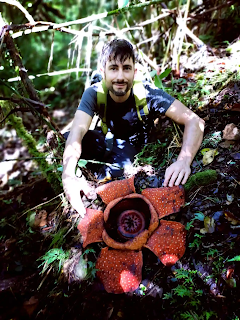Believe it or not, this is not a fungus. Or an alien species. It is a flower that lurks in the deepest rainforests of Luzon, in the Philippines.
It is a Rafflesia banaoana, a species of the genus that was named after Sir Stamford Raffles of Singapore fame. Close relatives can be found in Sumatra, Java, Borneo, but they are all in southeast Asia. And they are very, very rare.
Maybe it is alien. It has no roots, leaves, or stems. It is an utter parasite. Not only does it get its sustenance from the vine in which it lives, but it takes over the genes of the host as well. Weird, totally weird, like a manifestation of a virus in plant form.
So, the only part of the plant that exhibits itself is the flower. And how! A Rafflesia in Sumatra was measured at 120 centimeters -- almost four feet -- in diameter. The flower buds rise directly from the host vine, and spread out five huge petals, which smell like rotting flesh, and attract flies. Which is why it is rather aptly dubbed by some people "the corpse flower." But no, they do not digest the flies, like the Venus fly trap. The flies are for pollination purposes, like bees for more ordinary flowers.
Rafflesia was first discovered in the late eighteenth century in Java, by French naturalist Louis Deschamps, during the blossoming of the passion for natural history that was triggered by Joseph Banks and the Endeavour voyage. The first British naturalist to see a specimen was Joseph Arnold, when he was exploring the Sumatran rainforest in 1818.
Arnold got very excited, writing:
Here I rejoice to tell you I happened to meet with what I consider as the greatest prodigy of the vegetable world. I had ventured some way from the party, when one of the Malay servants came running to me ... To tell you the truth, had I been alone, and had there been no witnesses, I should, I think, have been fearful of mentioning the dimensions of this flower, so much does it exceed every flower I have seen or heard of.
Chris Thorogood, the deputy director of the Oxford Botanical Garden and Arboretum, got equally excited just recently. A prime ambition had been to find a specimen of what he calls 'the world's most whopping weird plant', and he did it!
And here is Chris and the flower he found.
He looks hot and tired but triumphant, and deservedly so. As The Guardian describes, the search was a real struggle.
By the time he got there he had been stung by vicious plants, and bitten by nasty leeches.
But what a find!










